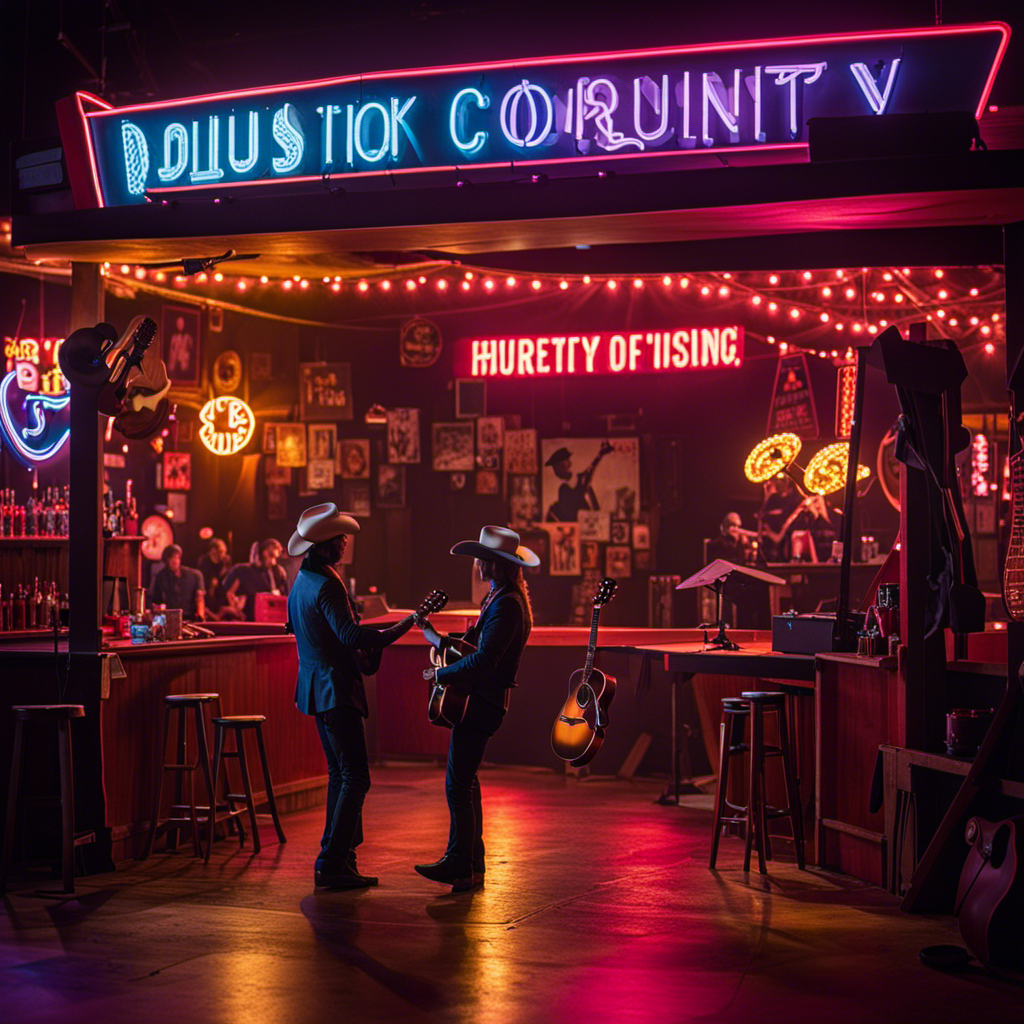Fun facts about country music: This guide uncovers 20 fascinating tidbits about the history, songs, and stars that made country music the beloved American genre it is today. From its deep roots in the rural South to legends like Johnny Cash, these fun facts will give you new appreciation for country music’s rich culture and enduring popularity.
Introduction
Country music is one of the most popular genres in the United States, with a rich history spanning over a century. From its early origins in the rural South to the genre’s modern-day superstars who sell out stadiums, country music has evolved dramatically over the decades while still maintaining its distinctive character and heartfelt style.
The great country songs and voices that shaped the genre created a sound that resonates deeply with many listeners. Behind the music are countless fascinating stories and facts about the people, songs, and events that developed country music into what it is today.
Here are 20 intriguing facts that provide insight into country music’s origins, pioneers, evolutions, legends, iconic songs, awards, and cultural impact. This is just a sampling of the captivating tales that reveal why country music holds such a special place in the hearts of fans worldwide.
Origins of Country Music
Country music arose from various folk music traditions of early European settlers in the Southern United States, blended with the musical influences of African slaves. The ballads, folk songs, and tunes brought by immigrants evolved into a distinctly Southern musical style that eventually became known as country music.
Fact 1
Country music has its roots in traditional folk music of early European immigrants in the Southern United States. The English, Irish, and Scottish immigrants brought the musical traditions of their homelands, including ballads and folk songs. Meanwhile, African slaves brought the banjo to America, which became a popular instrument that heavily influenced early country music. The blending of these various folk music styles in the rural South laid the foundation for what developed into modern country music.
Fact 2
The first commercial country music recording was made in 1923 by fiddler Eck Robertson. His recordings of “Arkansas Traveler” and “Turkey in the Straw” sold thousands of copies, proving the commercial appeal of old-time country music. This milestone recording session went down in history as the harbinger of country music’s rise in popularity as a commercial genre.
Robertson’s success paved the way for record companies to seek out and record other rural “hillbilly” music acts. The country music recording industry was born.
Fact 3
In 1927, the first “barn dance” radio show, WSM’s Grand Ole Opry, was broadcast weekly from Nashville, Tennessee. The show featured old-time country, gospel, and folk musicians performing live over the radio. This allowed country music to reach far beyond rural areas and gain wider audiences across the region.
The immediate popularity of the Opry revealed the broad appeal of country music. By the late 1920s, over 30 barn dance radio shows had popped up around the South and Midwest, cementing country music’s place in American popular culture. The Grand Ole Opry remains one of country music’s most iconic and enduring radio shows.
Pioneers of Country Music
In the late 1920s into the 1930s, the first generation of superstars helped country music blossom into a mainstream force in American music. Their songs and styles shaped the genre and propelled country music’s rising popularity.
Fact 4
Jimmie Rodgers and the Carter Family are considered the founders of country music. Jimmie Rodgers pioneered country music in the late 1920s with his trademark bluesy yodeling and his songs about rambling and railroads. He took early folk songs and transformed them into a distinct country style, greatly influencing future generations of artists.
At the same time, the Carter Family from Virginia popularized traditional ballads and older folk songs. With hits like “Wildwood Flower” and “Keep on the Sunny Side,” they became country music’s first commercially successful group act. Both Rodgers and the Carter Family rose to stardom through their recordings in the late 1920s.
Fact 5
Hank Williams is one of country music’s earliest superstars, pioneering the honky-tonk style. Rising to fame in the 1940s until his untimely death at age 29, Williams produced classics like “I’m So Lonesome I Could Cry,” “Your Cheatin’ Heart,” “Hey Good Lookin’,” and “Jambalaya.” His songs often told stories of hardship and heartache, echoed by his yodeling and emotive vocal style.
Williams took the country jukebox sound in a bluesier, rock and roll direction that came to define the honky-tonk style. His new electrified sound made the country genre more appealing to younger audiences and helped propel country music into the mainstream pop charts for the first time. He became an enormous commercial success that influenced generations of artists.
Fact 6
Patsy Cline crossed over from country to pop with her smokey, jazz-influenced vocals. Hits like “Crazy,” “I Fall to Pieces,” and “Walkin’ After Midnight” made her one of country music’s first female superstars in the early 1960s. Cline took country music in a more pop-oriented direction and became widely admired for her emotional, nuanced singing style.
Her rich contralto vocals communicated vulnerability and heartbreak like no one else. Songs like “Crazy” showed she could flawlessly walk the line between traditional honky-tonk and big voiced pop. Cline opened doors for future women in country music and remains one of its most influential vocalists.
Evolution of Country Music
As country music grew and changed through the mid-20th century, new sounds emerged that expanded the boundaries of the genre while keeping its roots intact. Bluegrass, country rock, and country pop developed as country music continued gaining widespread popularity.
Fact 7
Bluegrass music emerged after WWII, led by Bill Monroe’s fast-paced mandolin style. In the late 1930s, Monroe formed the Blue Grass Boys band and pioneered a lively acoustic string band sound that came to define bluegrass. With breakneck solos and vocal harmonies, Monroe created an upbeat new branch on country music’s tree. His 1945 hit “Blue Moon of Kentucky” was a blueprint for the high lonesome bluegrass sound.
Stars like Lester Flatt, Earl Scruggs, and the Stanley Brothers built upon Monroe’s rapid, banjo-driven style. The high energy bluegrass they created became a major strand within country music.
Fact 8
The late 1960s saw the rise of country rock and the “California sound.” Rock and folk rock artists like The Byrds, Gram Parsons, and Linda Ronstadt began infusing country themes and instrumentation into mainstream pop rock. Songs like “Sing Me Back Home” and “Sweetheart of the Rodeo” brought country music to young rock audiences.
Meanwhile, country stars like Glen Campbell and Kenny Rogers adopted a smooth, pop-friendly sound later dubbed the “California sound.” Campbell’s “Wichita Lineman” and other crossovers demonstrated country could be modern, sophisticated pop. This fusion expanded country’s appeal and left its mark on music far beyond just country.
Fact 9
Country pop crossover hits surged in the 1980s with artists like Kenny Rogers, Dolly Parton, and Willie Nelson. Slick, radio-friendly country love songs became wildly popular across genres. Kenny Rogers dominated the pop and country charts with hits like “The Gambler” and “Coward of the County.”
Dolly Parton’s “9 to 5” was not only a #1 country hit but also an Academy Award nominated movie theme. Willie Nelson paired with Julio Iglesias to sing the Latin-tinged megahit “To All the Girls I’ve Loved Before.” Country music adapted a distinctly polished, pop sound to draw huge mainstream audiences.
Country Music Legends
Beginning in the 1950s, a new generation of country music legends arose who would change and define the genre. Their distinctive voices, songs, and charisma made them icons to generations of fans.
Fact 10
Johnny Cash, the “Man in Black,” is considered one of country’s greatest icons. With his deep baritone voice and sparse, bass-driven sound, Cash created country classics like “I Walk the Line,” “Folsom Prison Blues,” and “Ring of Fire.” His stripped-down style made him an outlaw figure, but songs like “Hurt” also showed vulnerability.
Hits like “A Boy Named Sue” blended country storytelling with folk and rock. Cash became a cornerstone of country music for over five decades with his resonant voice and train-like rhythm. His black wardrobe also made him one of country’s most recognizable rebel images.
Fact 11
Dolly Parton remains country music’s most successful female artist to date. Her big hair, flamboyant personality, and powerhouse vocals have entertained generations of fans. With rags-to-riches songs like “Coat of Many Colors” and “9 to 5,” Parton embodied the working-class country woman.
Romantic ballads like “Jolene” and “I Will Always Love You” became iconic crossover smashes. Parton also crossed over to TV and film, always maintaining her down-home country image. She paved the way for all other female stars in country music.
Fact 12
Garth Brooks brought stadium rock energy to country in the 1990s. His smash live shows and rock-styled anthems like “Friends in Low Places” made him the best-selling solo artist in country music history. Songs like “The Dance” and “The Thunder Rolls” blended storytelling with arena rock spectacular.
Brooks’ explosive concerts with wireless headsets demonstrated country could rival rock and pop. He made country music larger-than-life while retaining its emotional directness. Other ’90s stars like Shania Twain soon followed in Brooks’ epic footsteps as country conquered the mainstream.
Iconic Country Songs and Albums
Certain songs and albums came along that not only topped the charts but resonated so deeply with listeners they became cultural touchstones. The most impactful country songs convey a universal message through simple poetry, memorable melodies, and emotive performances.
Fact 13
“He Stopped Loving Her Today” by George Jones is considered by many the greatest country song of all time. Released in 1980, the tragic tale of unrequited love until death featured Jones’ nuanced vocals. The song about finally getting over lost love after years of anguish tapped into strong emotions for listeners. Country legend Jones poured his own life’s pain into the performance. The song revived Jones’ career and remains untouchable as pure country poetry.
Fact 14
The soundtrack to O Brother Where Art Thou launched a roots music revival in 2000. Produced by rock artist T Bone Burnett, the album featured Alison Krauss, Emmylou Harris, and other artists covering old-time country, gospel, and bluegrass tunes. Songs like “I Am A Man of Constant Sorrow” introduced classic country to totally new audiences.
The immense crossover success sparked a renewed mainstream interest in Americana music. Country seemed fresh again by revisiting its roots. Many credit O Brother with priming the pump for a roots music revival that still continues today.
Fact 15
Taylor Swift’s 2006 self-titled debut album helped country music find younger audiences. At age 16, Swift’s vivid songwriting on hits like “Teardrops on My Guitar” made country relatable and cool for teenagers. Her mix of catchy melodies with emotional vulnerability struck a chord across generations. Swift’s unprecedented crossover appeal foreshadowed her later full-on pop stardom. But her introduction through country helped the genre gain an enthusiastic new youth following.
Country Music Awards and Events
A thriving industry of country music awards shows, festivals, and concerts grew as the genre exploded in popularity. These high-profile events recognizes top talents and brings country music lovers together.
Fact 16
The CMA Awards are country music’s longest running annual awards show, airing on TV since 1968. Often called “country music’s biggest night,” the industry votes for top performers, songs, albums, and new artists. Winning a CMA Award is a coveted achievement that can boost record sales and cement an artist’s stardom. The televised ceremony has become a major production showcasing elaborate musical performances.
Fact 17
Stagecoach, Coachella’s country music sister festival, premiered in 2007. Held at the same California site as the Coachella rock festival, Stagecoach tapped into surging mainstream interest in country concerts. It quickly became the genre’s biggest annual event, drawing over 75,000 fans each April to see mega-stars perform. The festival demonstrated country music’s young fan base hungry for an immersive concert experience.
Fact 18
CMA Fest (Fan Fair) draws tens of thousands of country fans to Nashville each June for four days of concerts. Started in 1972 as Fan Fair, the festival allows fans to interact with artists through autograph sessions, Q&As, and live music performances. Now spanning multiple concert stages across Nashville, CMA Fest has become a huge production. The city enjoys an economic boost from the droves of country lovers who flock there to get closer to the stars.
Country Music Culture and Lifestyle
Beyond the music, country also represents a larger culture and way of life. Its traditions have roots in the rural South, inspiring iconic dances, clothing styles, and values.
Fact 19
Line dancing originated in country bars and honky tonks in the 1970s. Upbeat step dances like the Two Step, El Paso, Cotton Eye Joe, and Electric Slide became popular in country-themed venues. The dances’ simple repetitive steps meant anyone could join without a partner. Line dancing’s popularity spread across the world, fueled by country music’s infectious dance rhythms. Bars still set aside dance floors devoted to country line dancing.
Fact 20
Country music is strongly linked to Southern culture and rural small-town life. The grandfathered-in traditions and simple values associated with country life are commonly romanticized in songs. Nostalgia for the past, nature, patriotism, family, and hardship reflect country music’s rural working-class roots.
Even as country music evolves, those cultural touchstones still resonate strongly with many fans. The powerful connection to a traditional way of country life remains an integral part of the genre’s identity and success.
Conclusion
Country music has certainly traveled a long road from its humble beginnings in Southern folk and hillbilly songs to becoming a worldwide commercial juggernaut. But even with all of country’s evolutions and incorporations of other genres, the music still maintains a distinctive spirit at its core. That timeless appeal keeps drawing new generations of fans.
These 20 facts provide just a sampling of the intriguing history and culture behind country music. There are still countless captivating stories and details waiting to be discovered that reveal why this uniquely American art form holds such a special place in so many hearts. For over a century now, country music has provided the soundtrack for many lives. Its evolution continues today, but country’s soul remains.





